John Stuart, 3rd Earl of Bute
| The Right Honourable The Earl of Bute KG PC | |
|---|---|
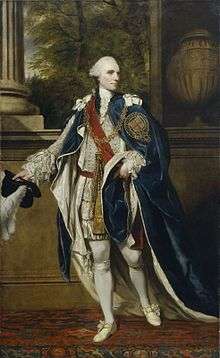 | |
| Prime Minister of Great Britain | |
|
In office 26 May 1762 – 8 April 1763 | |
| Monarch | George III |
| Preceded by | The Duke of Newcastle |
| Succeeded by | George Grenville |
| Leader of the House of Lords | |
|
In office 26 May 1762 – 8 April 1763 | |
| Monarch | George III |
| Prime Minister | himself |
| Preceded by | The Duke of Newcastle |
| Succeeded by | unknown |
| Secretary of State for the Northern Department | |
|
In office 25 March 1761 – 27 May 1762 | |
| Monarch | George III |
| Prime Minister | The Duke of Newcastle |
| Preceded by | The Earl of Holdernesse |
| Succeeded by | George Grenville |
| Personal details | |
| Born |
John Stuart 25 May 1713 |
| Died |
10 March 1792 (aged 78)
|
| Resting place | St Mary's Chapel, Rothesay, Isle of Bute |
| Nationality | Scottish and British |
| Political party | Tory |
| Spouse(s) | |
| Children | 11, including |
| Parents |
James Stuart, 2nd Earl of Bute Lady Anne Campbell |
| Alma mater | Leiden University |
John Stuart, 3rd Earl of Bute, KG, PC (/bjuːt/; 25 May 1713 – 10 March 1792) was a British nobleman who served as Prime Minister of Great Britain (1762–1763) under George III. He was arguably the last important favourite in British politics. He was the first Prime Minister from Scotland following the Acts of Union in 1707 and the first Tory to have held the office.
Biography
Early life and rise to prominence
He was born on Parliament Close, close to St Giles Cathedral on the Royal Mile in Edinburgh on 25 May 1715, the son of James Stuart, 2nd Earl of Bute, and his wife, Lady Anne Campbell. He was educated at Eton College.[1]
A close relative of the Clan Campbell (his mother was a daughter of the 1st Duke of Argyll), Bute succeeded to the Earldom of Bute (named after the Isle of Bute) upon the death of his father, James Stuart, 2nd Earl of Bute, in 1723. He was brought up thereafter by his maternal uncles, the 2nd Duke of Argyll and Archibald Campbell, 3rd Duke of Argyll, 1st and only Earl of Ilay, Viscount and Earl of Hay. Bute studied at Eton College (1720–1728) and the University of Leiden, Netherlands (1728–1732), where he graduated with a degree in civil and public law. On 24 August 1736, he married Mary Wortley Montagu (daughter of Sir Edward and Lady Mary Wortley Montagu), bringing the large Wortley estates to his family. In 1737, due to the influence of his uncles, he was elected a Scottish representative peer, but he was not very active in the Lords and was not reelected in 1741. For the next several years he retired to his estates in Scotland to manage his affairs and indulge his interest in botany.
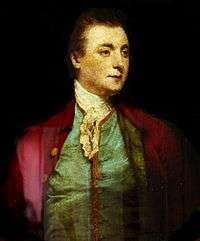
| Part of the Politics series on |
| Toryism |
|---|
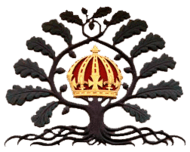 |
During the Jacobite rising of 1745, Bute moved to Westminster, London, and two years later met Prince Frederick, the Prince of Wales there, soon becoming a close associate of the Prince. Upon the Prince's death in 1751, the education of his son, Prince George, the new Prince of Wales, became a priority and in 1755 Bute was appointed as his tutor. Bute arranged for the Prince and his brother Prince Edward to follow a course of lectures on natural philosophy by the itinerant lecturer Stephen Demainbray. This led to an increased interest in natural philosophy on the part of the young prince and was one in a series of events that led to the establishment of the George III Collection of natural philosophical instruments. Furthermore, following the death of the Prince Frederick, Bute became close to his widow, Augusta of Saxe-Gotha, the Dowager Princess of Wales. It was rumoured that the couple were having an affair, and indeed soon after John Horne Tooke (an associate of the Prince of Wales) published a scandalous pamphlet alluding to a liaison between Bute and the Princess. Rumours of this affair were almost certainly untrue, as Bute was by all indications happily married, and he held sincere religious beliefs against adultery. In 1780 Bute was elected as the first President of the Society of Antiquaries of Scotland.
Premiership
Because of the influence he had over his pupil, Bute expected to rise quickly to political power following George's accession to the throne in 1760, but his plans were premature. It would first be necessary to remove both the incumbent Prime Minister (the Duke of Newcastle) and arguably the even more powerful Secretary of State for the Southern Department (William Pitt the Elder).[2] The Government of the day, buoyed by recent successes in the Seven Years' War, was popular, however, and did well at the general election which, as was customary at the time, took place on the accession of the new monarch.[3]
Supported by the king, Bute manoeuvred himself into power by first allying himself with Newcastle against Pitt over the latter's desire to declare war on Spain which, when defeated, precipitated Pitt's resignation and then forcing Newcastle's resignation when the Prime Minister found himself in a small minority within the Government over the level of funding and direction of the war.[4] Re-elected as a Scottish representative peer in 1760, Bute was indeed appointed the de facto Prime Minister, thus ending a long period of Whig dominance.
Bute's premiership was notable for the negotiation of the Treaty of Paris (1763) which concluded the Seven Years' War. In so doing, Bute had to soften his previous stance in relation to concessions given to France, in that he agreed that the important fisheries in Newfoundland be returned to France without Britain's possession of Guadeloupe in return.[5]
After peace was concluded, Bute and the King decided that Britain's military expenditure should not exceed its pre-war levels but they thought a large presence was necessary in America to deal with the French and Spanish threat. They therefore charged the colonists for the increased military levels, thus catalysing the resistance to taxes which led to the American Revolution.[6]
King George began to see through Bute, and turned against him after being criticised for an official speech which the press recognised as Bute's own work. Bute also proposed a controversial Cider tax which produced enormous hostility in cider-producing areas.
The journalist John Wilkes published a newspaper called The North Briton, in which both Bute and the Dowager Princess of Wales were savagely satirised. Bute resigned as prime minister shortly afterwards, although he remained in the House of Lords as a Scottish representative peer until 1780. He remained friendly with the Dowager Princess of Wales, but her attempts to reconcile him with George III proved futile.
Post-premiership
For the remainder of his life, Bute remained at his estate in Hampshire, where he built himself a mansion called High Cliff near Christchurch.[7] From there he continued his pursuit of botany and became a major literary and artistic patron. Among his beneficiaries were Samuel Johnson, Tobias Smollett, Robert Adam, William Robertson and John Hill. He also gave considerably to the Scottish universities. His botanical work culminated in the publication of Botanical Tables Containing the Families of British Plants in 1785. Even after his retirement, Bute was accused by many Americans in the years leading up to the American Revolutionary War as having an undue corrupting influence over the British government.[8] He died at his home in South Audley Street, Grosvenor Square, Westminster, from complications of a fall suffered while staying at Highcliffe, and was buried at Rothesay on the Isle of Bute.[7]
The flowering plant genus Stuartia is named after him. According to historian John Naish, the 18th-century expression "Jack Boot" meaning a stupid person originated as disparagement of Stuart's performance as Prime Minister.[9]
Luton Hoo
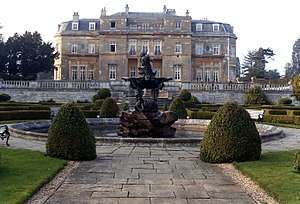
The Earl held the Manor of Luton and had Luton Hoo designed and built by the neoclassical architect Robert Adam. Work commenced in 1767. The original plan had been for a grand and magnificent new house. However, this plan was never fully executed and much of the work was a remodelling of the older house. Building work was interrupted by a fire in 1771, but by 1774 the house, though incomplete, was inhabited. Dr. Samuel Johnson visiting the house in 1781 is quoted as saying, "This is one of the places I do not regret coming to see...in the house magnificence is not sacrificed to convenience, nor convenience to magnificence".
Death
He died on 10 March 1792 at his London address, South Audley Street off Grosvenor Square.[10]
Family
In 1736 he married Mary Wortley Montagu. They had at least ten children:
- Lady Mary Stuart (c. 1741 – 5 April 1824), married James Lowther, later created Earl of Lonsdale, on 7 September 1761
- John Stuart, Lord Mount Stuart (30 June 1744 – 16 November 1814), politician who succeeded as 4th Earl of Bute and was later created Marquess of Bute
- Lady Anne Stuart (born c. 1745), married Hugh Percy, Lord Warkworth, later the 2nd Duke of Northumberland, on 2 July 1764
- The Hon James Archibald Stuart (19 September 1747 – 1 March 1818), politician and author
- Lady Jane Stuart (c. 1748 – 28 February 1828), married George Macartney, later created Earl Macartney, on 1 February 1768
- The Hon Frederick Stuart (1751–1802), politician[11]
- The Hon Charles Stuart (January 1753 – 25 May 1801), soldier and politician
- The Hon William Stuart (March 1755 – 6 March 1822), Anglican prelate who served as Archbishop of Armagh
- Lady Caroline Stuart (before 1763 – 20 January 1813), married The Hon John Dawson, later the 1st Earl of Portarlington, on 1 January 1778
- Lady Louisa Stuart (12 August 1757 – 4 August 1851), writer who died unmarried[12]
Styles of address
John Stuart was variously styled:
Gallery
 The north and south fronts of Luton Hoo as designed by Robert Adam
The north and south fronts of Luton Hoo as designed by Robert Adam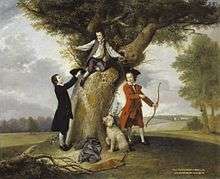 The three sons of the Earl of Bute
The three sons of the Earl of Bute The three daughters of the Earl of Bute
The three daughters of the Earl of Bute
Notes
- ↑ Biographical Index of Former Fellows of the Royal Society of Edinburgh 1783–2002 (PDF). The Royal Society of Edinburgh. July 2006. ISBN 0 902 198 84 X.
- ↑ Browning, Reed (1975). The Duke of Newcastle. London: Yale University Press Ltd. p. 271. ISBN 0300017464.
- ↑ Browning 1975, pp. 272-274.
- ↑ Browning 1975, pp. 275-88.
- ↑ Schweizer, Karl (1988). Lord Bute – Essays in Reinterpretation. Great Britain: Leicester University Press. pp. 27–29. ISBN 0718512618.
- ↑ Schweizer 1988, pp. 17-35.
- 1 2 Schweizer (2009).
- ↑ Bailyn, Bernard (1992). The Ideological Origins of the American Revolution. The Belknap Press of Harvard University Press. ISBN 0-674-44302-0.
- ↑ Naish, John (1996). The Interwoven Lives of George Vancouver, Archibald Menzies, Joseph Whidbey and Peter Puget: The Vancouver Voyage of 1791–1795. The Edward Mellen Press, Ltd. ISBN 0-7734-8857-X.
- ↑ Biographical Index of Former Fellows of the Royal Society of Edinburgh 1783–2002 (PDF). The Royal Society of Edinburgh. July 2006. ISBN 0 902 198 84 X.
- ↑ Schweizer, Karl Wolfgang (October 2009) [2004]. "Stuart, John, third earl of Bute (1713–1792)". Oxford Dictionary of National Biography (online ed.). Oxford University Press. doi:10.1093/ref:odnb/26716.
|access-date=requires|url=(help) (Subscription or UK public library membership required.) - ↑ Miller, Karl (January 2006) [2004]. "Stuart, Lady Louisa (1757–1851)". Oxford Dictionary of National Biography (online ed.). Oxford University Press. doi:10.1093/ref:odnb/42015.
|access-date=requires|url=(help) (Subscription or UK public library membership required.) - ↑ IPNI. Stuart.
References


- Schweizer, Karl Wolfgang (October 2009) [2004]. "Stuart, John, third earl of Bute". Oxford Dictionary of National Biography (online ed.). Oxford University Press. doi:10.1093/ref:odnb/26716. (Subscription or UK public library membership required.).
External links
- More about John Stuart, Earl of Bute on the government history blog.
- The Age of George III: The ministry of John Stuart, third Earl of Bute
| Political offices | ||
|---|---|---|
| Preceded by The Earl of Holdernesse |
Secretary of State for the Northern Department 1761–1762 |
Succeeded by George Grenville |
| Preceded by The Duke of Newcastle |
Prime Minister of Great Britain 26 May 1762 – 8 April 1763 | |
| First Lord of the Treasury 1762–1763 | ||
| Court offices | ||
| Preceded by Edward Finch |
Keeper of the Privy Purse 1760–1763 |
Succeeded by William Breton |
| Records | ||
| Preceded by The Earl of Chatham |
Oldest living Prime Minister of Great Britain 1778–1792 |
Succeeded by Lord North |
| Peerage of Scotland | ||
| Preceded by James Stuart |
Earl of Bute 1723–1792 |
Succeeded by John Stuart |
.svg.png)